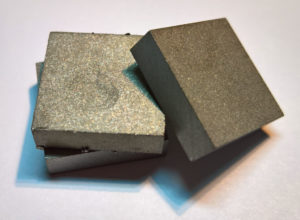Sintered samarium-cobalt (SmCo) permanent magnet materials were developed in the 1970s based on rare earth (SE) and 3d transition metal alloys. We distinguish between two types of samarium-cobalt materials, SmCo5 and Sm2Co17.
Advantages of SmCo permanent magnet materials are their excellent corrosion resistance and a high temperature resistance compared to NdFeB permanent magnet materials, resulting from the low temperature coefficients. In addition, compared to NdFeB, SmCo permanent magnet materials offer the economic advantage that experience has shown that the raw materials for these materials are subject to less price fluctuations. Conversely, for the customer this means a more stable price basis for products based on these material series.
SmCo5
Are intermetallic materials based on the compound samarium1-cobalt5. The materials can be used up to about 250°C and are characterized by excellent corrosion and temperature resistance. To achieve the maximum magnetic properties (remanences of 0.8 – 1.0 Tesla), magnetization fields of up to 2500 kA/m are required.
SmCo5-Data for download (PDF)
Sm2Co17
These are permanent magnet materials based on the compound Sm2Co17, and by the targeted addition of Fe, Cu and Zr the coercivity can be adjusted from about 1500 – 3000 kA/m. Compared to SmCo5, they are characterized by even lower temperature coefficients of remanence and coercivity. This allows maximum application temperatures of up to 350°C to be achieved. Disadvantageous, especially for the magnetization of magnet systems, are the very high required magnetization fields, which can be up to 6000 kA/m. Added to this is a high brittleness, which can cause problems during mechanical processing.
Sm2Co17-Data for download (PDF)

 Deutsch
Deutsch


